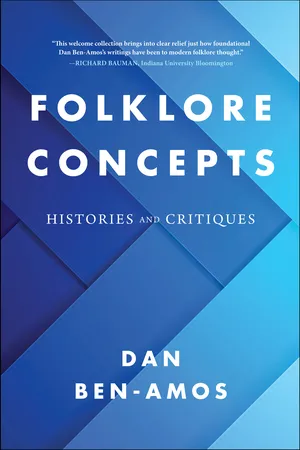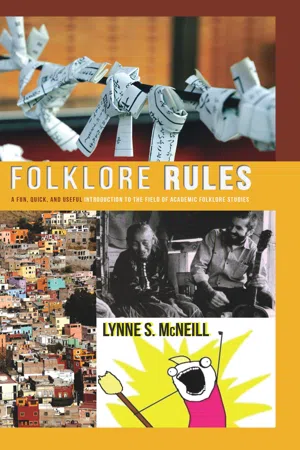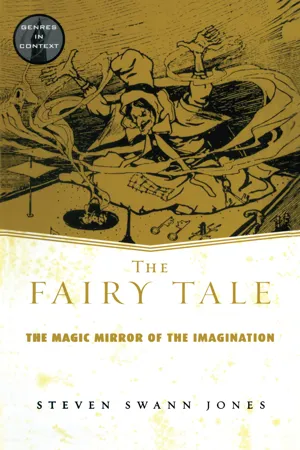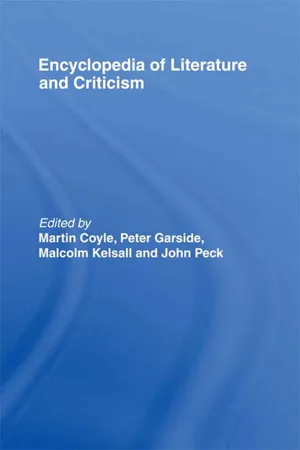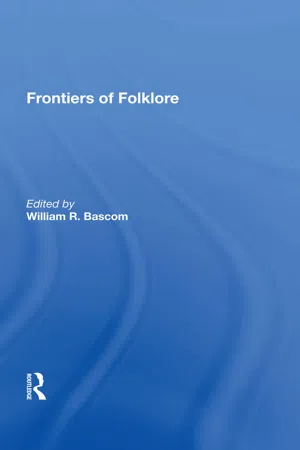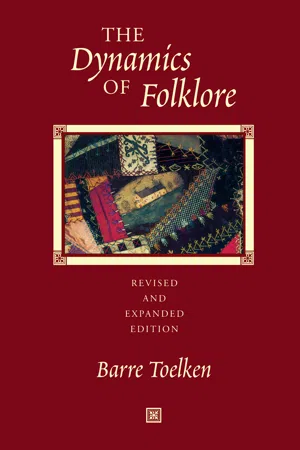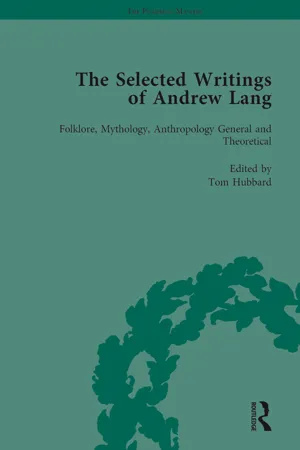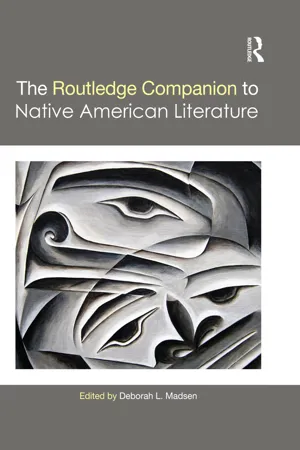Literature
Folklore
Folklore refers to the traditional beliefs, customs, stories, and practices passed down within a community through oral tradition. It encompasses a wide range of cultural expressions, including myths, legends, folk tales, proverbs, songs, and rituals. Folklore often reflects the values, history, and identity of a particular group or society.
Written by Perlego with AI-assistance
Related key terms
Related key terms
1 of 4
Related key terms
1 of 3
10 Key excerpts on "Folklore"
- eBook - ePub
Folk Stories and Personal Narratives in Palestinian Spoken Arabic
A Cultural and Linguistic Study
- N. Sirhan(Author)
- 2014(Publication Date)
- Palgrave Macmillan(Publisher)
3
The Lore and Tales of the Folk
3.1 Folklore – an overview
Folklore, as referred to here, is a subset of the oral tradition which includes legends, myths, tales, fables, folk tales, anecdotes, songs, riddles and speeches. As with many genres, defining Folklore is no simple task. It cannot simply be based on its form of transmission – oral – since ‘all Folklore is orally transmitted, but not all that is orally transmitted is Folklore’ (Dundes 1965a; b: 25). Reynolds (2007: 35) defines Folklore as ‘all of the many different ways we express who we are as members of a particular group – a family, an ethnic group, a fraternity, a religious community, and so on – but which we have learned directly from other people rather than from books, television, or movies’. Taylor (2002: 34) defines Folklore as ‘the material that is handed on by tradition, either by word of mouth or by custom and practice’. The universality of Folklore is undeniable since evidence shows that each and every community has its own form of Folklore (Bascom 1965a: 26; b). In spite of the universality of Folklore, it is vital to approach it with the material in mind and not to attempt to impose upon it preconceived ideas or theories. Folklore is a part of a society’s culture and a window into that same society. It also serves to reveal how a society views the world and its many facets.Folklore also represents a communicative event and a form of narrative that can transcend man-made boundaries, classes and societies. Folklore is indiscriminate; its medium of delivery, the spoken word, requires no studied learning, allowing it to flow freely and disseminate itself among all members of society. According to Propp (1984: 5), ‘Folklore is the output of all strata of the population except the ruling one; the latter’s verbal art belongs to literature’. Although Folklore became the domain of the masses, the ruling class cannot be completely excluded from its creation. Since storytelling is a custom practised by all social strata, it follows that all classes partook, to some extent, in its formation, preservation and dissemination. - eBook - ePub
Folklore Concepts
Histories and Critiques
- Dan Ben-Amos, Henry Glassie, Elliott Oring(Authors)
- 2020(Publication Date)
- Indiana University Press(Publisher)
3 TOWARD A DEFINITION OF Folklore IN CONTEXTD EFINITIONS OF Folklore ARE AS MANY AND VARIED as the versions of a well-known tale. Both semantic and theoretical differences have contributed to this proliferation. The German Volkskunde, the Swedish folkminne, and the Indian lok sahitya all imply slightly different meanings that the English term Folklore cannot syncretize completely (Eriksson 1955; Hultkranz 1960, 243–49; Legross 1962; Lutz 1958). Similarly, anthropologists and students of literature have projected their own biases into their definitions of Folklore. In fact, for each of them, Folklore became the exotic topic, the green grass on the other side of the fence, to which they were attracted but which, alas, was not in their own domain. Thus, while anthropologists regarded Folklore as literature, scholars of literature defined it as culture (cf. Bascom 1949; Espinosa 1949; Herskovits 1949; Leach 1949). Folklorists themselves resorted to enumerative (Bayard 1953, 9–10; Dundes 1965, 1–3; Merton 1846), intuitive (Botkin 1944, xxi; Utley 1968), and operational (Utley 1961) definitions; yet while all these certainly contributed to the clarification of the nature of Folklore, at the same time, they circumvented the main issue—namely, the isolation of the unifying thread that joins jokes and myths, gestures and legends, costumes and music into a single category of knowledge.The difficulties experienced in defining Folklore are genuine and real. They result from the nature of Folklore itself and are rooted in the historical development of the concept. Early definitions of Folklore were clouded by romantic mist and haunted by the notion of “popular antiquities,” which Thoms sought to replace.1 Implicit in these definitions are criteria of the antiquity of the material, the anonymity or collectiveness of composition, and the simplicity of the folk, all of which are circumstantial and not essential to Folklore. The age of a song, for example, establishes it chronologically; the identification of the composer describes it historically; and its association with a particular group defines it socially. Each of these factors has an explanatory and interpretive value, but none of them defines the song as Folklore. Thus, the principles that united “customs, observance, superstitions, ballads, proverbs, etc.” in Thoms’s initial definition of Folklore were not intrinsic to these items and could only serve as a shaky framework for the development of a scientific discipline concentrating on them.2 - eBook - ePub
Folklore Rules
A Fun, Quick, and Useful Introduction to the Field of Academic Folklore Studies
- Lynne S. McNeill(Author)
- 2013(Publication Date)
- Utah State University Press(Publisher)
So finally, many pages later, we have reached our answer: Folklore is informal, traditional culture. Those three words are our shorthand for the whole general mish-mash of what Folklore is. In those three words we are reminded of the importance of both halves of the word folk-lore: without the folk (people sharing an informal culture) we wouldn’t have dynamic variation, and without the lore (the stories, beliefs, and customs), we wouldn’t have anything to pass on traditionally. It’s a big concept in a small package.So What?
The definition of Folklore as “informal traditional culture” is much broader than many people initially expect, and it also helps to work against the common misperception that Folklore has to be old (and rural, backward, and untrue). For a long time, back when folklorists thought the “folk” were peasants, folklorists thought that all Folklore was slowly disappearing from the world as peasant populations were becoming more educated and economically independent. The conception of Folklore as informal traditional culture, however, highlights that Folklore is always coming into and falling out of use. A particular item of Folklore may indeed disappear if it’s no longer relevant to people’s lives, but Folklore on the whole will never disappear—we’ll always have informal, traditional aspects to our cultural lives.16This is a pretty uplifting message, if you think about it. We’ve got a lot going on in the realm of culture these days—globalization, McDonaldization, homogenization, digitization, depersonalization—lots of -izations that make people worry about the cultural, expressive, and interpersonal future of the human race. To be sure, Folklore isn’t all butterflies and rainbows—it includes racist, sexist, xenophobic, and vulgar content as often as not17 - eBook - ePub
- Steven Swann Jones(Author)
- 2013(Publication Date)
- Routledge(Publisher)
In order to define the fairy tale genre, we must first identify the preliterate heritage from which these tales emerged. We need to understand the process of oral narration and the characteristics of oral transmission in order to understand why fairy tales as one kind of folk narrative take the form they do. Second, we need to review previous attempts to classify and catalog the multitudinous products of oral tradition. For over a century, folklorists have tried to differentiate and to index the various forms of folk narrative, including fairy tales, so we need to build on their findings. Third, from this theoretical foundation, we may begin to deduce what are the essential qualities characterizing the genre. Part of this task involves differentiating fairy tales from related genres such as myths and legends. Ultimately, we may then use this folkloristic definition of the fairy tale to identify literary examples that emulate or imitate the Folklore model.The Preliterate Heritage
To understand the heritage of the fairy tale fully, we must first recognize the mechanics of oral transmission—the ability of people to create and retell stories without the aid of books. The majority of the world’s best-known and most loved fairy tales, including “Snow White,” “Jack and the Beanstalk,” “Sleeping Beauty,” and “Cinderella,” were all initially the product of Folklore. The importance of Folklore in our literate society is underestimated, however, perhaps because the very concept of Folklore is not well understood. We tend to be condescending toward traditional culture and to think of it as represented primarily by the quaint costumes and peculiar customs of backward people. But Folklore includes all the forms of cultural learning passed on by word of mouth or personal example in any group. Folklore flourishes in preindustrial, industrial, and “postindustrial” societies— not only along the Congo or the Amazon. Folklore includes all the traditional forms of expression that circulate without the aid of books—the art, speech, and literature created through personal interaction rather than through the printed medium. Rap music, for example, has a large oral component, as it is performed and perpetuated on the sidewalks of New York and other cities, and it may be seen as an outgrowth of the folk tradition of “toasting” as it was performed in African-American culture. Likewise, quilting continues to be a popular art form passed on by personal example from parent to child, neighbor to friend, in farming communities all across America. Much like these other art forms, jokes continue to flourish as an oral tradition in all walks of life—young and old pass on jokes they have heard from others. And, of course, a host of fairy tales, such as “East o’ the Sun, West o’ the Moon” (also known in its literary versions as “Beauty and the Beast” or “Cupid and Psyche”), “Aladdin’s Lamp,” “The Spirit in the Blue Light” (also known in its literary version as “The Tinder Box”), “The Dragon Slayer,” “The Shoes That Were Danced to Pieces,” “Little Red Riding Hood,” “Hans the Hedgehog,” “Rapunzel,” “Rumplestiltskin,” and “The Frog King,” owe their existence to folk tradition. - eBook - ePub
- Martin Coyle, Peter Garside, Malcolm Kelsall, John Peck(Authors)
- 2002(Publication Date)
- Routledge(Publisher)
Nicolaisen’s (1980 , p. 139) happy term, ‘register of culture’ maintained and transmitted primarily by word of mouth and customary practice. It follows, therefore, that folk literature, the literature of folk culture, is the literature maintained and transmitted primarily by word of mouth, that is, by verbal means rather than by manuscript or print. That of course is not to say that it never reaches manuscript or print; naturally it does, but that does not diminish its status as folk literature; it does not suddenly metamorphose into high literature, for the material still continues being transmitted by the traditional verbal processes.Medium
Folk literature has its own medium, genres, conventions, aesthetics, and hence its own critical methodology. Its medium is tradition. Where high literature relies primarily though not exclusively on a visual medium, that of print, folk literature relies primarily on an aural medium. Where high literature relies primarily on the written word, folk literature relies primarily on the performed word. The aural medium, tradition, acts as channel for the performance of the word and means of transmission; it also constitutes the matrix of the processes engendered by the dynamics of performance and transmission. As the medium of folk literature, then, tradition may be most briefly defined as a set of processes central to which is word-of-mouth transmission. From the chronological viewpoint, tradition has two stages, what one might call the preliterate and the postliterate or the preindustrial and postindustrial. In the first stage, the time of prevalent nonliteracy before the industrial revolution, word-of-mouth tradition pervaded the life of all the people who could not read and write: it was, in a quite encompassing sense, their means of both ‘instruction and delight’. In the second stage, the time of general literacy after the industrial revolution, word-of-mouth tradition had many of its functions gradually taken over by print, writing and ‘official’ education, but it continued adaptively within its contracted range, retaining older material and creating new, and becoming increasingly the carrier of unofficial culture. Earlier antiquarians tended to search exclusively for relics of the preliterate stage as evidence of folk tradition, but modern students of folk literature take both stages as their province, considering both historical and contemporary phenomena. Folk literature, then, consists of the literary and linguistic products of both preliterate and postliterate tradition. - eBook - ePub
- William R Bascom(Author)
- 2019(Publication Date)
- Routledge(Publisher)
15 ). Nevertheless, the encounter with narratives and songs, sayings and riddles in their cultural and situational contexts has already forced us to rethink our fundamental conceptual framework for Folklore and to reformulate the relations between Folklore and other verbal systems of communication, primarily literature. The effects of the ‘new perspectives’ extend beyond description, shattering basic assumptions that were at the roots of many a theory about Folklore, culture, and progress. Such ideas evolved together with the emergence of modern systematic thought and knowledge during the seventeenth and eighteenth centuries and were incorporated, probably without critical awareness, into modern research in the social sciences and the humanities.Literature and Folk-Literature
The idea of Folklore, if not the term, evolved as the dark side of the enlightment, the contraries of the new ideals to which the age aspired. Rationalism “regarded the folk and its creative, especially literary, products with contempt and derision, as lacking in refinement, learning, mastery of diction, and subtleness and elevation of thought. This aristocratic attitude toward folk literature is characteristic of the Rationalistic movement” (16 ). The romantics, who extolled the very poetry the rationalists despised, reversed the attitude towards and valuation of the folk and its literature, but they did not reject the basic dichotomy inherent in the set of opposites of literature and folk- literature. Herder, who coined the partially synonymous terms Volkslitteratur , Volkspoesie , and Naturpoesie (17 ), considered the folk (Volk ) from political, social, educational and historical perspectives. The folk is the ruled, as opposed to the ruling, part of a people, and often is synonymous with the notion of nation itself. It is the less educated group within a nation, and also those people in ancient and modern times that have not yet reached a sophisticated level of civilization. This last characteristic is particularly important since it also implies that “the Volk is a class apart from philosophers, poets, and orators; a class different from sages. Not being wise and learned, they must be those upon whom artificial methods of training and culture have had less effect than upon the philosophers, poets, and orators. They are therefore more nearly the natural man” (18 ). Following Rousseau, and more closely his teacher Hammann, Herder idealized the natural man, and admired his poetic expression. For him, folk- literature achieved “the highest degree of harmony between the personality of the individual author, his subject, and the collective personality of his native audience or ethnic environment. Folk poetry, therefore, is to him the highest type and the final standard of all poetry” (19 - eBook - ePub
Living Folklore
Introduction to the Study of People and their Traditions
- Martha Sims, Martine Stephens(Authors)
- 2005(Publication Date)
- Utah State University Press(Publisher)
Because of the fluid nature of the field, and the fact that it is built from so many influences, Folklore continues to evolve and change. It’s not just that people change, but that our opportunities for expression change; the influence of the Internet, for instance has had profound impact on how people communicate, and new forms and adaptations of Folklore have emerged as a result. That means that what folklorists say about performances and texts generated through these new means will change as well. Part of what we do as folklorists is discuss these changes as they arise, and continually examine our assumptions about groups of people and how they share Folklore.The study of Folklore encompasses so many types of expression that it’s almost impossible not - eBook - ePub
- Barre Toelken(Author)
- 1996(Publication Date)
- Utah State University Press(Publisher)
Virtually every state has an office of folklife programs or a folk arts coordinator (often working within the state arts agency). These professional folklorists help to document and nurture the folk arts of their areas, often producing radio and television shows, tape and CD recordings, and live presentations which showcase the active traditions of local communities. They often create festivals which bring all the groups together in an exciting celebration of their varied cultural expressions: for example, the Living Traditions Festival, held annually in Salt Lake City, Utah, presents more than 80 ethnic groups who share their foods, stories, dances, songs, and customs with other interested citizens. Other state festivals center on a single local ethnic group, or an occupation (like fishing or logging). The public sector folklorists do not cause the Folklore to happen, but rather encourage its retention and call attention to its role in the rich fabric of local society.Folklore is used as an introduction to literature in the schools, especially where ballads and folksongs can provide a vivid example of poetic and musical talents of people in general that can offset the notion that poetry is composed—and understood—only by rare geniuses. One of the most widespread and exciting uses of Folklore today requires folklorists and teachers to collaborate in bringing folk artists and craftspersons into public school classrooms in order to show how deeply the vernacular arts intersect with arts generally, as well as with history, language, society, and science. The Arts-in-Education programs of many state arts councils now routinely employ professional folk-lorists to bring about this meeting of traditional performers with learners of all ages. Folklore is sometimes used in retirement homes where people can maintain mental exercise and a sense of cultural stability by sharing jokes, anecdotes, songs, and historical reminiscences that express the validity of their own lives.All the activities described in this chapter fall under the category of applied Folklore because their functions rest on the assumption that one must go beyond the simple intellectual discussion of Folklore to gain certain ends. Whether those ends are served by massive government programs on the one extreme or by individual folklorists acting as consultants to schools, companies, and other groups who need cultural perspectives, applied Folklore exists as a very broad field of cultural knowledge in action. As a set of possibilities that show the continued importance of Folklore study in the modern world, applied Folklore allows for a great number of meaty answers to that important analytical question, “So what?” - eBook - ePub
The Selected Writings of Andrew Lang
Volume I: Folklore, Mythology, Anthropology; General and Theoretical
- Tom Hubbard(Author)
- 2016(Publication Date)
- Routledge(Publisher)
But the method of Folk-lore is to study these rural customs and notions as survivals, relics enduring from a mental condition of antiquity far higher than that of literary Rome or Greece. We do not say that, as a rule, this harvest rite, or vernal custom, or story filtered out of Ovid down into the peasant class. Rather we say that, as a rule, Ovid is describing and decorating some rural customs or tale which is infinitely older than his day, and which may be, and often is, shared with Roman agriculturists by the peasants of France and England, and also by natives of lands undiscovered by the civilised races of the old world. The method of Folk-lore rests on the hypothesis of a vast common stock of usage, opinion, and myth, everywhere developed alike, by the natural operation of early human thought. This stock, or much of it, is everywhere retained by the unprogressive, uneducated class, while the priests and poets and legislators of civilisation select from it, and turn customs into law, magic into ritual, story into epic, popular singing measures into stately metres, and vague floating belief into definite religious doctrine. Thus, briefly to give examples, the world-wide custom of the blood-feud becomes the basis of the Athenian law of homicide. The savage magic which is believed to fertilise the fields becomes the basis of the Attic Thesmophoria, or of the Eleusinian legend and mysteries. The rural festivities of Attica become the basis of the Greek drama. The brief singing measures of the popular song become the basis of the hexameter. The sacrifice of the sacred animal of the kindred becomes a great source of Greek ritual - Deborah L. Madsen, Deborah L. Madsen(Authors)
- 2015(Publication Date)
- Routledge(Publisher)
28 The Historical and Literary Role of Folklore, Storytelling, and the Oral Tradition in Native American Literatures
Susan Berry Brill de RamírezDOI: 10.4324/9781315777344-28To understand any written literature, attention needs to be paid to its craft, its distinctive language and rhetoric, its style and form, its literariness. This is especially true for Native American literatures which are deeply informed by their respective tribal traditions of storytelling and oratory. And to begin to understand Native American literature, attention must be paid to the language, form, rhetoric, and literariness which are (1) in many cases reflective of present and past oral traditions and (2) integrally tied to tribal literary and linguistic heritage and influence. While the primacy of oral traditions as historically significant is a fact for all literatures, Native American literature stands out due to its ancestrally and culturally genetic positioning between its traditional, tribal oral cultures, languages, and rituals and its place as part of the larger American and Canadian literary canons. The precedence of orality in relation to literacy and textuality is a global fact: in terms of chronology, all written literatures have oral literary traditions as precedent and formative. However, for all of the tribes of North America, the shift to a predominantly written culture has been relatively recent within the global history of writing – for many tribes, largely occurring just within the past two centuries.
Index pages curate the most relevant extracts from our library of academic textbooks. They’ve been created using an in-house natural language model (NLM), each adding context and meaning to key research topics.
Explore more topic indexes
Explore more topic indexes
1 of 6
Explore more topic indexes
1 of 4

